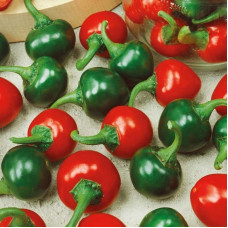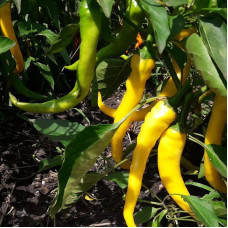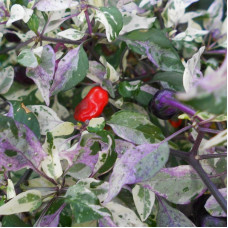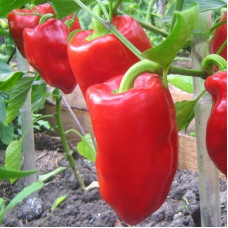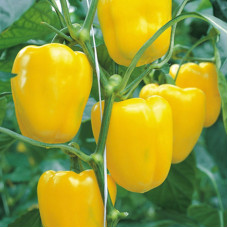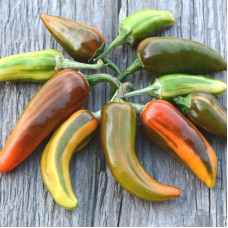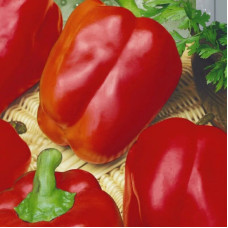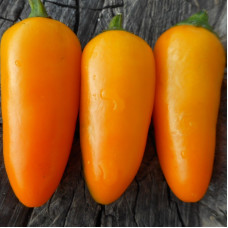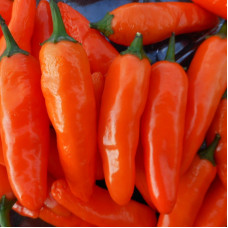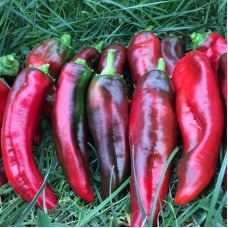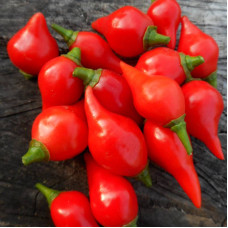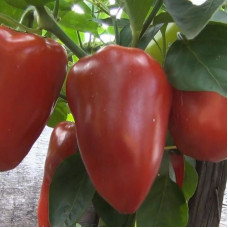In stock
Product Code: 10256
Hot pepper (bitter) «Cherry» - mid-early variety. The period from germination to ripeness is 120-130 days. The bush is semi-standard, 60-80 cm high. The fruits are round, smooth, 2-4 cm in diameter, bright red, very fragrant. On average, the weight o..
$0.99
In stock
Product Code: 15318
Hot pepper «Yellow ram's horn»
This is a mid-season variety of hot pepper. Vegetation period from germination to biological maturity is 130-150 days. The bush is strong, 45-55 cm high. Fruits up to 20 cm long, curved, bright red. Fruit diameter 2...
$0.99
In stock
Product Code: 7962
Hot pepper (bitter) «Purple tiger»- a beautiful and decorative bush with leaves in white and green. Small fruits when ripe change color from dark purple to red. Pre-sowing treatment with biological products and soaking according to the instructions f..
$0.99
In stock
Product Code: 1013
Sweet pepper «Gift of Moldova»
Semi-spreading, semi-stem plant 35-45 cm high. Hanging fruits. Productivity up to 7 kg/m2. For open ground and film tunnels.
Ripening time: mid-season. Ripens in 125-136 days after full shoots. The fruits are coni..
$0.99
In stock
Product Code: 12386
Sweet pepper «Asti yellow»
This is an early variety of sweet pepper. Vegetation period 105-115 days. Bush 50-70 cm high. Cuboid-shaped fruits 10x10 cm, thick-walled, four-chambered, weighing 180-200 grams. In technical ripeness, the fruit is green..
$0.99
In stock
Product Code: 12011
Hot chili pepper«Anaheim»
Mid-season variety, from sowing to the first harvest 90 days. The fruits are large - 15-25 cm long, 4.5-5.5 cm wide, thick-walled, cone-shaped flattened, with a pointed or concave end, weighing 100-150 grams. In technical..
$0.99
In stock
Product Code: 12985
Sweet pepper «Marinkin tongue» - mid-early variety with very attractive bright red fruits. From germination to technical maturity 100 days. The shape of the fruit is a cone slightly flattened laterally, reminiscent of a tongue, red in color. The skin..
$0.99
-20%
$0.79
In stock
Product Code: 11817
Sweet pepper «Lyubasha»
Mid-season variety of pepper (130-135 days), the shape of the fruit is wide-cone-like. The plant is compact, standard. The color of the fruit is light yellow, bright red. Fruit length 15-20 cm. Fruit wall thickness 6-8 mm. ..
$0.99
-20%
$0.79
In stock
Product Code: 4333
Hot pepper (bitter) «Variegated Fish» - is an amazingly beautiful variety of hot pepper! A variegated bush with striped fruits in technical ripeness, and when fully ripe, the fruits turn red. The fruits are elongated, sharp.
Suitable for growing i..
$0.99
Out Of Stock
Product Code: 2782
Sweet pepper «Palan Babura» - this is an early ripening, high-yielding variety. The growing season from germination to biological ripeness is 100-110 days. The bush is spreading, 40-50 cm high. The fruits are large, prismatic in shape, very juicy, br..
$0.99
Out Of Stock
Product Code: 12977
Hot pepper (bitter) «Jalapeno NuMex Orange Spice» - is a variety of mid-season hot peppers selected by the Chile Institute. The variety is obtained by crossing Pemagreen sweet peppers (remains green when fully ripe) with Jalapeno Early hot peppers. T..
$0.99
Out Of Stock
Product Code: 12896
Sweet pepper «Chocolate» - mid-early variety. The growing season from germination to biological ripeness is 115-130 days. The bush is compact, 70-80 cm high. The fruits are cube-shaped, smooth, fleshy, weighing 120-130 grams, chocolate brown in color..
$0.99
Out Of Stock
Product Code: 12978
Hot pepper (bitter) «Jalapeno NuMex Pumpkin Spice» - is a mid-season variety, the growing season is 100-110 days. The fruits are orange in color, juicy, fleshy, thick walls and fruity aroma, weighing up to 100 grams. The bush is compact, 60 cm ..
$0.99
Out Of Stock
Product Code: 12959
Sweet pepper «Cockatoo» F1 - is mid-season (130-135 days from germination to the beginning of fruiting), a highly productive hybrid for growing in greenhouses. It has excellent properties that make it possible to obtain the best harvest of fleshy swe..
$1.99
Out Of Stock
Product Code: 12323
Hot (bitter) pepper «Biquinho red» - an excellent productive small-fruited variety with red peppers. The fruits are conical or with a sharp nose, shiny, pungency from low to strong. They will be good in marinades, for whole-fruit canning and fresh, e..
$1.99
Out Of Stock
Product Code: 6276
Sweet pepper«Victoria» - is a mid-season variety of pepper. Vegetation period from germination to biological ripeness is 140-160 days. The fruiting period is 45-55 days. Standard bush, 45-50 cm high. Fruits are cone-shaped, smooth, slightly ribbed, b..
$0.99
Pepper Features
Today, there are over 700 types of pepper seeds. Initially, this word denoted a genus of plants of the Pepper family. Now this terminology is used depending on the scope. In cooking, there are three main types: white, green, black. Their difference is only in ripeness and time of collection. A popular variety is the thick-walled specimen.
Initially, pepper appeared in Mexico and Guatemala, Columbus brought it to Europe, like potatoes. First, he was entrenched in the culinary culture of Spain, then England, Hungary, Greece, Bulgaria. It appeared on our territory in the sixteenth century and took root so much that local farmers began to seat it at an enviable speed. And with the advent of science in human life, peppers were found to be bred, creating hybrid species and all kinds of product variations. After 5 centuries, this vegetable has not lost its former popularity, but has only become even more firmly entrenched in the gastronomic cult of almost all countries of the world.
Pepper dishes have been familiar to us since childhood, it can be stuffed, baked, canned or chopped into lecho. Unfortunately, today's prices make it an unaffordable luxury to be able to buy natural vegetables. For residents of country houses, this is all the more not the most rational solution. Therefore, more and more people do without shops, growing vegetable products in the garden. Do not be upset or the inhabitants of the apartments – some peppers can be grown in a pot. To carry out this process, only favorable conditions for the life of the plant and high-quality pepper seeds are needed, which will be discussed further.
Initially, pepper appeared in Mexico and Guatemala, Columbus brought it to Europe, like potatoes. First, he was entrenched in the culinary culture of Spain, then England, Hungary, Greece, Bulgaria. It appeared on our territory in the sixteenth century and took root so much that local farmers began to seat it at an enviable speed. And with the advent of science in human life, peppers were found to be bred, creating hybrid species and all kinds of product variations. After 5 centuries, this vegetable has not lost its former popularity, but has only become even more firmly entrenched in the gastronomic cult of almost all countries of the world.
Pepper dishes have been familiar to us since childhood, it can be stuffed, baked, canned or chopped into lecho. Unfortunately, today's prices make it an unaffordable luxury to be able to buy natural vegetables. For residents of country houses, this is all the more not the most rational solution. Therefore, more and more people do without shops, growing vegetable products in the garden. Do not be upset or the inhabitants of the apartments – some peppers can be grown in a pot. To carry out this process, only favorable conditions for the life of the plant and high-quality pepper seeds are needed, which will be discussed further.
Pepper seed classification
As mentioned, there are an incredible number of varieties. So many that a person who has no experience in agriculture will not understand what's what. & nbsp; Of all the species and subspecies classifications, one can single out the most familiar to every European. Pepper seeds are divided into the following types:
- Hot pepper. The most popular variety is chili, even hotter Jalapeno, waxy Hungarian, Jamaican, red Cherry pepper and others. Despite the pungency, they contain a large amount of useful substances. They are digestion catalysts, used for chronic diseases, diseases of the stomach and intestinal tract in some cases. In the East, flatulence is cured with the help of the pungent Habanero. Due to its small size in most species, it is well suited for growing at home. The process of sowing seeds is recommended to be carried out in winter. You also need to carefully approach the preparation of the soil, laying it out in layers: humus, leafy soil, sand. Indoor hot pepper bushes do not respond well to transplantation, so you need to take care of the "growth" pot in advance.
- Sweet pepper. The second name, which is more popular, is Bulgarian. There are different colors: from yellow to purple. Growing this type is a more complicated procedure and is unlikely to suit inexperienced farmers. Preparing for planting takes a lot of time and knowledge. Sowing pepper seeds – the beginning of the most crucial period, ending with the emergence of seedlings. After all, on the "conscience" the seeds themselves are only 20% failures, 80% - non-compliance with growing technologies. Therefore, it is more reliable to sow germinated seeds for seedlings, which reduce the likelihood of poor germination. To begin with, the purchased seeds must be soaked in infused water with aloe leaves or a small amount of potassium permanganate. This will not harm the plant in any way, but rather relieve harmful bacteria and damage. Seeds should be watered abundantly until the first leaves appear.
How to choose seeds
There are no special technologies for choosing pepper seeds, they are the same and differ in what fruits we get at the end. It is worth choosing, starting from the place of residence: a private house or an apartment. Also, an important factor in choosing is whether it is late or early. The first type matures in about 140 days, while the second takes almost half the time. It is imperative to find out if you are allergic to one or another variety, since this product can also have a negative effect on a sick organism.

